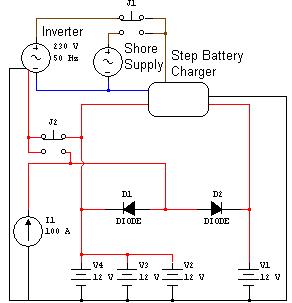- Joined
- 27 Jan 2008
- Messages
- 23,630
- Reaction score
- 2,662
- Location
- Llanfair Caereinion, Nr Welshpool
- Country

The switch J2 changes the inverter supply from the alternator to the domestic batteries this I am not sure on as I don't know how the inverter will handle the rectified 3 phase supply? A fourth small battery less than 20Ah may be required to smooth supply to inverter? Again the switch could be a relay energised by the alternator output.
The idea is that when the alternator is running any power over and above what the inverter requires will be supplied direct to batteries in normal manor. So after starting the batteries will charge as normal. However once the current starts to drop to under 25A then the Step Battery charger should raise the three domestic batteries voltage to 14.4/14.8V according to DIP switch setting until the current drops to 2.5A or 4/8 hours has elapsed according to DIP switch setting.
If this system will work the only item, which needs buying, is the inverter. The main idea is to reduce the charge time so with deep discharged batteries in the morning they are likely to be charged by the evening when the main engine is finished with.
It looks so simple I worry I have missed something. Any comments welcome.
Eric


